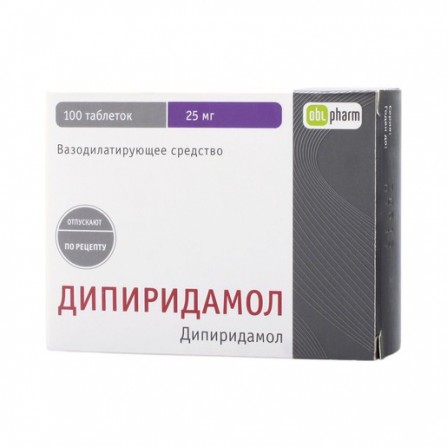Dipiridamol-OBL pills coated 25mg N100
Condition: New product
1000 Items
Rating:
Be the first to write a review!

More info
Active ingredients
Dipyridamole
Release form
Pills
Composition
Dipyridamole 25 mg. Auxiliary substances: corn starch - 11.75 mg, lactose monohydrate - 11 mg, magnesium stearate - 1.25 mg, talc - 0.5 mg, gelatin - 1 mg, colloidal silicon dioxide - 0.5 mg. The composition of the dragee shell: sucrose - 24.314 mg, calcium carbonate - 3.796 mg, magnesium hydroxycarbonate - 1.322 mg, talc - 1.322 mg, macrogol 6000 - 1.536 mg, dextrose liquid (dry weight) - 1.456 mg, titanium dioxide - 1.024 mg, polyvidone ( K = 25) value - 0.213 mg, carnauba wax - 0.011 mg, quinoline yellow dye (Е104) - 0.006 mg.
Pharmacological effect
Antiplatelet, angioprotector, immunomodulator. It has a inhibitory effect on platelet aggregation, improves microcirculation. It has a vasodilating effect, lowers the resistance of resistive coronary vessels (mainly arterioles), increases the volumetric rate of coronary blood flow. Able to reduce the perfusion of ischemic zones of the myocardium. The mechanism of action is not fully understood. Dipyridamole is believed to increase the content of adenosine (disrupting its reuptake), and also to increase the concentration of cAMP due to inhibition of the PDE enzyme. As a pyrimidine derivative, dipyridamole is an interferon inducer and has a modulating effect on the functional activity of the interferon system, increases the decreased production of interferon alpha and interferon gamma leukocyte blood in vitro. Increases non-specific resistance to viral infections.
Pharmacokinetics
After oral ingestion, dipyridamole is completely absorbed from the gastrointestinal tract. Cmax in plasma is reached after 75 minutes. Plasma protein binding is high. T1 / 2 in the terminal phase is 10-12 hours. It is metabolized in the liver and is excreted in the bile mainly as glucuronides. Excretion may be slowed by enterohepatic recirculation. In a small amount is excreted in the urine.
Indications
Treatment and prevention of cerebral circulatory disorders of the ischemic type, dyscirculatory encephalopathy, primary and secondary prevention of coronary artery disease, especially in case of intolerance to acetylsalicylic acid, prevention of arterial and venous thrombosis and treatment of their complications, prevention of thromboembolism after surgery for heart valve replacement, prevention of a peritoneal peritoneum, prevention of a hearth and venous thrombosis; ; violations of microcirculation of any type (as part of complex therapy); prevention and treatment of influenza,SARS (as an interferon inducer and immunomodulator) - to receive the drug in a dose of 25 mg.
Contraindications
Increased sensitivity to the drug, acute myocardial infarction, unstable angina, common stenosing atherosclerotic coronary arteries; subaortic stenosis, aortic heart failure decompensation; hypotension; collapse, severe hypertension, severe cardiac arrhythmia, chronic obstructive pulmonary disease, chronic renal failure; liver failure; hemorrhagic diathesis; diseases with an increased risk of development are bleeding nd (including gastric ulcer and duodenal ulcer).
Precautionary measures
Use with caution in patients with hypotension, recent myocardial infarction, heart failure.
Use during pregnancy and lactation
During pregnancy and breastfeeding, it is possible if the intended benefit to the mother outweighs the potential risk to the fetus and baby (passes into the breast milk). The category of action on the fetus according to the FDA is B.
Dosage and administration
The dose of the drug is selected depending on the severity of the disease and the individual reaction of the patient. 75 mg 3 times a day is recommended for IHD. If necessary, the daily dose can be increased under the supervision of a physician. For the prevention and treatment of disorders of cerebral circulation, as well as for the prevention of prescribed 75 mg 3-6 times / day. The maximum daily dose is 450 mg. To reduce platelet aggregation, Curantil is prescribed at a dose of 75-225 mg / day in several doses. In severe cases, the dose may be increased to 600 mg / day. For the prevention of influenza and ARVI, especially during epidemics, Curantil N25 and Curantil 25 are prescribed 50 mg each (2 pills or 2 pills) / day in 1 dose. The drug is taken 1 time per week for 4-5 weeks. To prevent recurrence of ARVI in patients who frequently have respiratory viral infections, Curantil N25 and Curantil 25 are prescribed 100 mg / day (2 pills or pills 2 times / day with an interval between doses in 2 hours). The drug is taken 1 time per week for 8-10 weeks. Tablets should be taken on an empty stomach, without breaking and not cracking, with a small amount of liquid.The duration of the course of treatment is determined by the doctor.
Overdose
Symptoms: short-term reduction in blood pressure and tachycardia. Treatment: symptomatic therapy, including the introduction of vasopressor agents.
Interaction with other drugs
With the simultaneous use of agents that reduce the acidity of the contents of the stomach (antacids, blockers of histamine H2 receptors (including cimetidine), proton pump inhibitors (including omeprazole), the bioavailability of dipyridamole can be reduced. When used simultaneously with anticoagulants, acetylsalicylic acid increases antiplatelet action of dipyridamole. When used simultaneously with anticholinergics, impaired memory and attention are possible in elderly patients. Beta-adrenergic blocking agents are described in cases of bradycardia and asystole when dipyridamole is used in patients receiving beta-adrenergic blockers. When used simultaneously with adenosine, the effect of adenosine increases. When applied simultaneously with dobutamine, there is a risk of severe arterial hypotension. derivatives decreases the effectiveness of dipyridamole.
special instructions
There is evidence that with the on / in the introduction of dipyridamole possible uneven redistribution of blood flow in the coronary vessels and the development of robbery syndrome, accompanied by exacerbation of symptoms of angina (including depression of the ST segment on the ECG). In this regard, it is not recommended in / in the introduction of dipyridamole.




